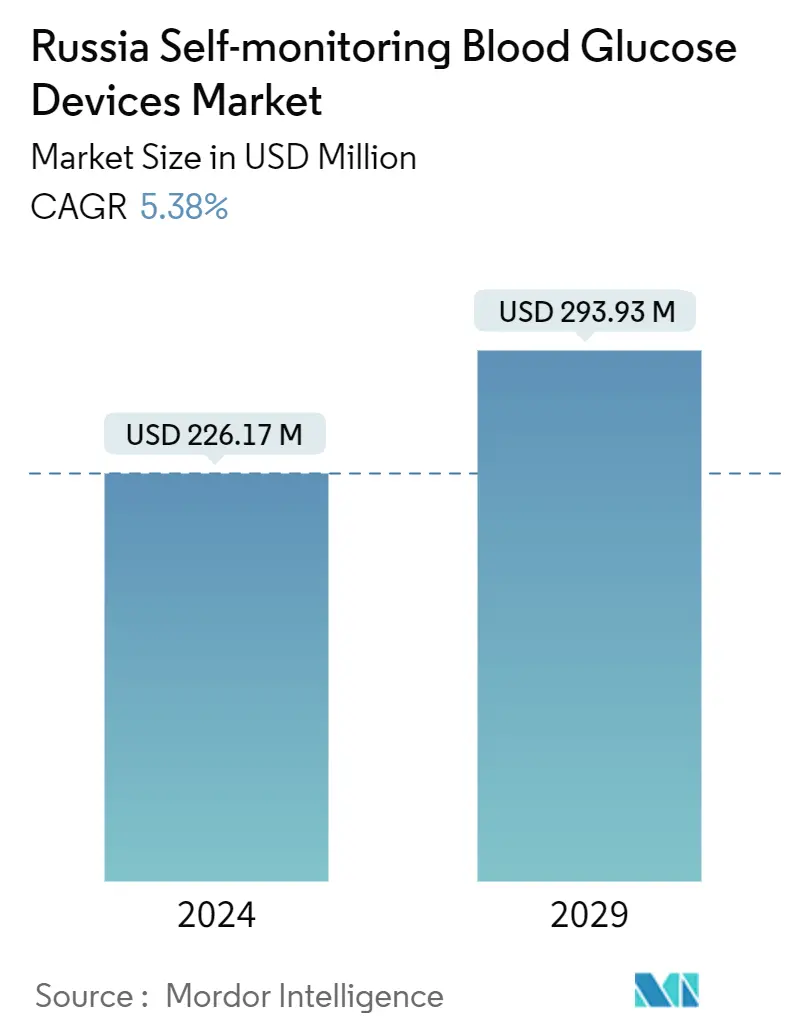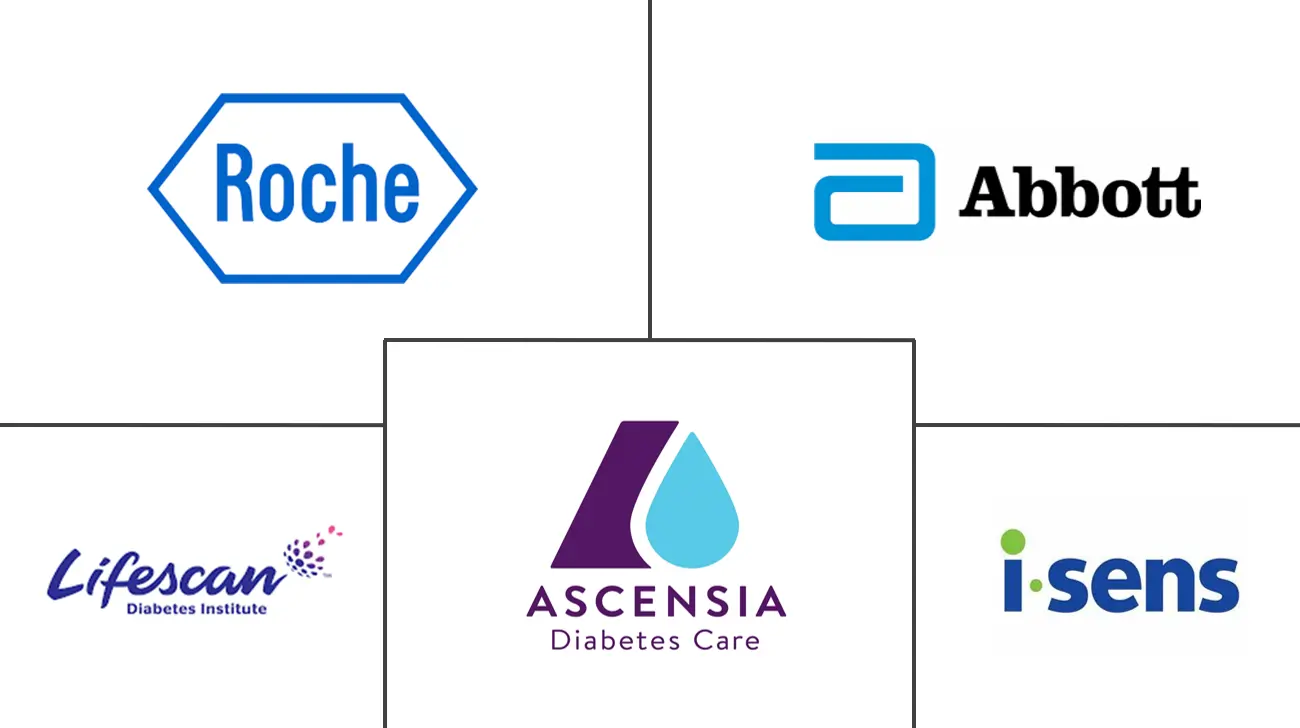Market Size of Russia Self-monitoring Blood Glucose Devices Industry

| Study Period | 2018-2029 |
| Base Year For Estimation | 2023 |
| Forecast Data Period | 2024 - 2029 |
| Market Size (2024) | USD 226.17 Million |
| Market Size (2029) | USD 293.93 Million |
| CAGR (2024 - 2029) | 5.38 % |
Major Players
*Disclaimer: Major Players sorted in no particular order |
Russia Self-monitoring Blood Glucose Devices Market Analysis
The Russia Self-monitoring Blood Glucose Devices Market size is estimated at USD 226.17 million in 2024, and is expected to reach USD 293.93 million by 2029, growing at a CAGR of 5.38% during the forecast period (2024-2029).
Diabetes patients were at a higher risk of being extremely unwell if infected with the virus during the COVID-19 pandemic. Diabetes was a risk factor for developing severe and critical forms of infection and was among the most frequently reported comorbidities in patients infected with COVID-19. Obesity, the main risk factor for incident type-2 diabetes, was more common in patients with critical forms of COVID-19 requiring invasive mechanical ventilation. As a result, the demand for self-monitoring blood glucose devices to monitor and maintain optimum blood glucose levels increased during the pandemic.
The measurement of blood glucose is necessary to keep the blood glucose levels within a specified target range. Blood monitoring glucose devices help understand the effectiveness of blood glucose metabolism and guide in achieving optimal glucose control within the body. Self-monitoring blood glucose devices allow a patient to check their blood glucose levels as often as they need to or as recommended by their doctor. Over time, the readings provide the patient and their health professionals with the information required to determine the best management strategy for diabetes.
According to the Diabetes UK report on diabetes in Russia published in September 2022, about fifty percent of diabetes cases are undiagnosed. The gaps in diabetes management by undiagnosed patients are expected to be filled through government support and initiatives over the forecast period. The growing diabetic population is expected to act as a driver for diabetes care devices. In obese individuals, the fat cells in the body release pro-inflammatory chemicals, which may make the body less sensitive to the insulin it produces by disrupting the function of insulin-responsive cells. Thus, these individuals need external insulin shots and must use a monitoring device, such as a glucometer. Technological advancements have increased over the period in Diabetes care devices for safer and more accurate administration of insulin. These therapies are only possible through proper Self-monitoring of blood glucose devices and self-care.
Russia Self-monitoring Blood Glucose Devices Industry Segmentation
Self-monitoring blood glucose devices are used for measuring the concentration of glucose in the blood for effective diabetes management. The Russian market for self-monitoring blood glucose devices is segmented into components (glucometer devices, test strips, and Lancets).
The report offers the value (in USD) and volume (in Units) for the above segments.
| Component | |
| Glucometer Devices | |
| Test Strips | |
| Lancets |
Russia Self-monitoring Blood Glucose Devices Market Size Summary
The Russian self-monitoring blood glucose devices market is poised for significant growth, driven by an increasing diabetic population and heightened awareness of diabetes management. The demand for these devices surged during the COVID-19 pandemic, as diabetes patients faced higher risks of severe infections, underscoring the importance of maintaining optimal blood glucose levels. Self-monitoring devices, such as glucometers, enable patients to regularly check their glucose levels, providing critical data for effective diabetes management. Technological advancements have led to the development of more user-friendly and accurate devices, enhancing their adoption in home care settings. The Russian government's initiatives, including the Federal Project Combating Diabetes Mellitus, aim to improve diabetes care infrastructure and access, further supporting market expansion.
The market is characterized by a mix of established and emerging players, with companies like Abbott, LifeScan, and Ascensia holding significant market shares. The glucometer segment is expected to experience the highest growth rate, driven by the increasing preference for home-based self-monitoring and recent product innovations. Government strategies and funding are focused on controlling the diabetes burden, which is a major healthcare challenge in Russia. As the prevalence of diabetes continues to rise, the market for self-monitoring blood glucose devices is anticipated to expand, offering both opportunities and challenges for manufacturers and healthcare providers in the region.
Russia Self-monitoring Blood Glucose Devices Market Size - Table of Contents
-
1. MARKET DYNAMICS
-
1.1 Market Overview
-
1.2 Market Drivers
-
1.3 Market Restraints
-
1.4 Porter's Five Forces Analysis
-
1.4.1 Bargaining Power of Suppliers
-
1.4.2 Bargaining Power of Consumers
-
1.4.3 Threat of New Entrants
-
1.4.4 Threat of Substitute Products and Services
-
1.4.5 Intensity of Competitive Rivalry
-
-
-
2. MARKET SEGMENTATION
-
2.1 Component
-
2.1.1 Glucometer Devices
-
2.1.2 Test Strips
-
2.1.3 Lancets
-
-
Russia Self-monitoring Blood Glucose Devices Market Size FAQs
How big is the Russia Self-monitoring Blood Glucose Devices Market?
The Russia Self-monitoring Blood Glucose Devices Market size is expected to reach USD 226.17 million in 2024 and grow at a CAGR of 5.38% to reach USD 293.93 million by 2029.
What is the current Russia Self-monitoring Blood Glucose Devices Market size?
In 2024, the Russia Self-monitoring Blood Glucose Devices Market size is expected to reach USD 226.17 million.

